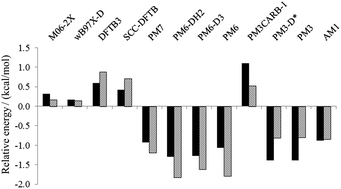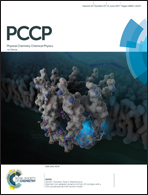Approximate quantum chemical methods for modelling carbohydrate conformation and aromatic interactions: β-cyclodextrin and its adsorption on a single-layer graphene sheet†
Abstract
Noncovalent functionalization of graphene by carbohydrates such as β-cyclodextrin (βCD) has the potential to improve graphene dispersibility and its use in biomedical applications. Here we explore the ability of approximate quantum chemical methods to accurately model βCD conformation and its interaction with graphene. We find that DFTB3, SCC-DFTB and PM3CARB-1 methods provide the best agreement with density functional theory (DFT) in calculation of relative energetics of gas-phase βCD conformers; however, the remaining NDDO-based approaches we considered underestimate the stability of the trans,gauche vicinal diol conformation. This diol orientation, corresponding to a clockwise hydrogen bonding arrangement in the glucosyl residue of βCD, is present in the lowest energy βCD conformer. Consequently, for adsorption on graphene of clockwise or counterclockwise hydrogen bonded forms of βCD, calculated with respect to this unbound conformer, the DFTB3 method provides closer agreement with DFT values than PM7 and PM6-DH2 approaches. These findings suggest approximate quantum chemical methods as potentially useful tools to guide the design of carbohydrate-graphene interactions, but also highlights the specific challenge to NDDO-based methods in capturing the relative energetics of carbohydrate hydrogen bond networks.



 Please wait while we load your content...
Please wait while we load your content...